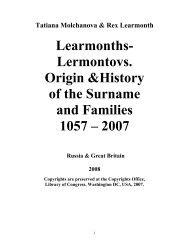LEARMONTH-LERMONTOV. A HYISTORY OF THE NAME AND FAMILIES
By Tatiana Molchanova and Rex Learmonth, 2011
By Tatiana Molchanova and Rex Learmonth, 2011
- No tags were found...
You also want an ePaper? Increase the reach of your titles
YUMPU automatically turns print PDFs into web optimized ePapers that Google loves.
Learmont’s mother could trace her lineage back to the<br />
great Scottish poet and seer of the thirteenth century, Sir<br />
Thomas Learmont of Ercildoune, better known as Thomas the<br />
Rhymer. Learmont. Drysdale’s maternal grandfather, George<br />
Learmont, was reared near Traquair House, where the Quair<br />
and Tweed Rivers join, and was Factor to the last Earls of<br />
Traquair for over forty years. This area spawned many<br />
legends, ballads and songs, which the young Learmont learned<br />
from his mother.<br />
On leaving school, he studied architecture for some<br />
time, but his interest in music led him to enrol at the Royal<br />
Academy of Music in London. After his student days,<br />
Drysdale taught for a short time at the Athenaeum in Glasgow,<br />
but the remainder of his fairly short life was devoted to<br />
composition. He produced a large number of songs and song<br />
arrangements, a few orchestral works, some instrumental<br />
chamber music, several operas and dramatic cantatas.<br />
He spent most of his working years in London,<br />
returning to Scotland only towards the end of his life. His<br />
extant compositions include theatrical and orchestral works,<br />
choral music, chamber pieces, numerous songs and folksong<br />
arrangements, though few of these were published.<br />
When the clergyman, novelist and folklorist Sabine<br />
Baring-Gould published his colorful novel of 18th-century<br />
country life, Red Spider, in 1887, it was so well received that<br />
he was persuaded to write an operatic version. During this<br />
period he was collaborating with fellow clergyman and<br />
musician Henry Fleetwood-Sheppard on their monumental<br />
collections of West Country folksong Songs and Ballads of the<br />
West (1891) and A Garland of Country Song (1895).<br />
Fleetwood-Sheppard agreed to provide the music for Red<br />
Spider which, in reflection of its Devonshire setting, was to be<br />
based on local traditional melodies. However, following a<br />
period of collaboration, Fleetwood-Sheppard withdrew from<br />
the project and Baring-Gould chose Learmont Drysdale as his<br />
new partner. Red Spider was Drysdale’s greatest public<br />
success. The work was extravagantly mounted and a first-rate<br />
company engaged with Lucy Carr-Shaw (1853-1920), singer,<br />
actress and sister of George Bernard Shaw, in the leading role.<br />
During the autumn of 1898, Red Spider toured Britain<br />
with a lengthy run that lasted for more than 100 performances,<br />
but, sadly, it has not been staged since (Moira A Harris:<br />
Learmont Drysdale’s Red Spider, Music in 19th-Century<br />
Britain Conference: Abstracts).<br />
As the result of the friendship which developed in the<br />
1940s between Henry Farmer and Drysdale’s sister Janey,<br />
who through the years had tried to promote her brothers works<br />
whenever possible, she was persuaded by Farmer to donate to<br />
Glasgow University Library many of Drysdale’s manuscript<br />
compositions, as well as a number of published pieces and a<br />
quantity of archival material. The Farmer Collection is an<br />
additional source of material on Drysdale as it includes many<br />
letters from Janey Drysdale to Henry Farmer concerning her<br />
brother’s music as well as other topics (The Special<br />
Collections Department. Henry George Farmers 1882-1965;<br />
Collection, University of Glasgow; Kenny M. Sheppard<br />
Selected choral works of Learmont Drysdale, Scotland’s<br />
forgotten composer, Texas Tech University, USA, 1987).<br />
Janey Drysdale was probably the first Learmonth who tried to<br />
establish the connection between her Learmonth family and<br />
the Russian poet Mikhail Yurievich Lermontov. Mr. Crocket,<br />
her close friend, made a request to Russia in 1913 to find the<br />
origin of Mikhail Lermontov’s family. The only fact that they<br />
found was Lermontov’s Scottish origin.<br />
One of the unusual and touching memories for all the<br />
Learmonth-Lermontov families was George Learmont’s work<br />
‘Thomas the Rhymer’ that was restored and orchestrated by<br />
the famous Russian composer Edward Artemiev in 2007, for<br />
the 950th Anniversary of the Learmonth surname.<br />
- 201 -<br />
- 202 -






